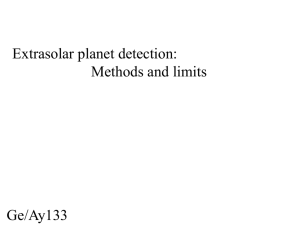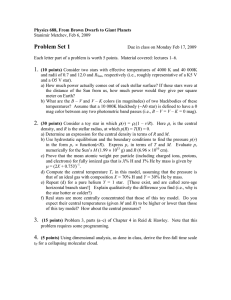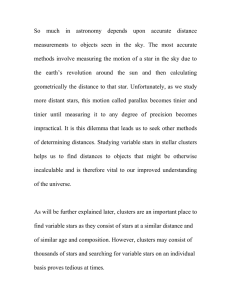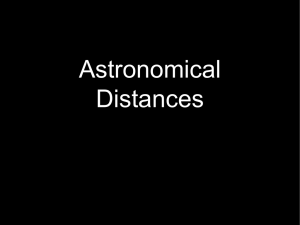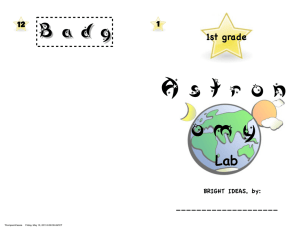Astrometry: Revealing the Other Two Dimensions of Velocity Space H.A. McAlister
advertisement
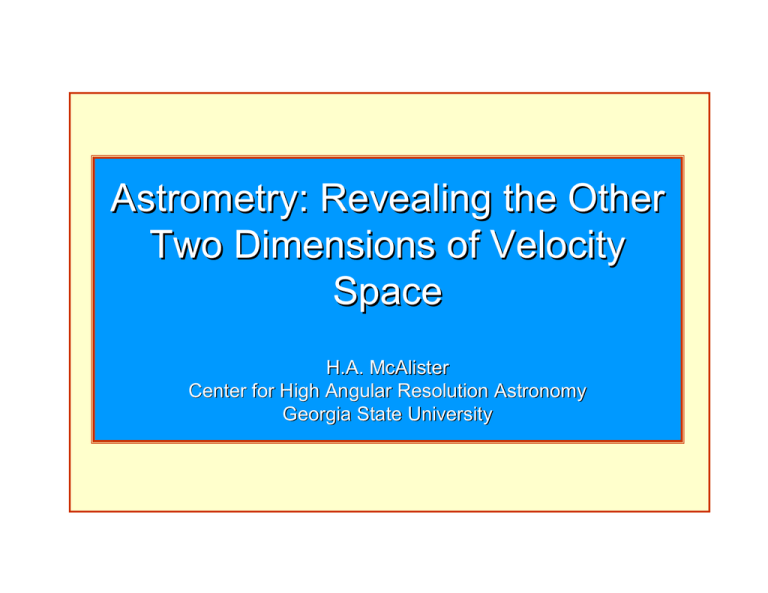
Astrometry: Revealing the Other Two Dimensions of Velocity Space H.A. McAlister Center for High Angular Resolution Astronomy Georgia State University Astrometry: What is It? • Astrometry deals with the measurement of the positions and motions of astronomical objects on the celestial sphere. Two main subfields are: • • Spherical Astrometry – Determines an inertial reference frame, traditionally using meridian circles, within which stellar proper motions and parallaxes can be measured. Also known as fundamental or global astrometry. • Plane Astrometry – Operates over a restricted field of view, using, through much of the 20th century, long-focus refractors at plate scales of 15 to 20 arcsec/mm, with the goal of accurately measuring stellar parallax. Also known as long-focus or small-angle astrometry. Astrometry relies on specialized instrumentation and observational and analysis techniques. It is fundamental to all other fields of astronomy. Astrometry: What are its tools? • Spherical Astrometry: • • • • • • Meridian circles & transits Astrolabes Space (eg. Hipparcos) Phased optical interferometry Very long baseline radio interferometry Plane Astrometry: • • • • • • • • Photography (until relatively recently) Visual Micrometry (until relatively recently) CCD imaging Scanning photometry Speckle interferometry (O/IR) Michelson interferometry (O/IR) Radio interferometry Space (imaging & interferometry) Some 19th & 20th C. Astrometric Instruments Greenwich Meridian Circle House USNO 6-in Transit Circle 1898-1995 Photo from National Maritime Museum, Greenwich W. Finsen’s Eyepiece Interferometer c. 1960 Worley’s recording filar micrometer at USNO U.S. Naval Observatory Photo U.S. Naval Observatory Photo Hipparcos Test 1988 ESA Photo Spherical Astrometry What does it measure? Spherical Astrometry attempts to measure stellar & planetary positions and motions in an inertial reference frame. This is very challenging and must account for effects of: • • • • • Proper motion Parallax Galactic rotation Precession Nutation • • • • • Aberration Polar wandering Refraction Solar motion Earth dynamics (including time) Oh, yeah, and whatever the heck systematics are in your instrumental and reduction methodology! A truly inertial reference frame has been achieved through the tie-in to extragalactic radio sources using VLBI. Sound difficult? It is! Plane Astrometry What does it measure? Plane Astrometry attempts to measure small angle effects relative to a background of one or more reference stars. These effects include: • • • • • • Proper motion Parallax (relative and absolute) Secular acceleration Sub-motions arising from unseen companions Binary star relative separation and orientation Stellar diameters And, here again, whatever the heck systematics are in your instrumental and reduction methodology! Also sound difficult? It is! Astrometry What does it give us? Spherical Astrometry gives us: • • • • • Galactic kinematics and dynamics Solar system dynamics Time Periodic and secular changes in Earth orientation Navigation (mostly historical except during WWIII) Plane Astrometry gives us, when combined with other techniques, stellar: • • • • • Luminosities Masses Diameters (and shapes) Temperatures Multiplicity frequencies • • • • Space velocities Distribution in solar neighborhood Unseen companions Calibration of cosmic distance scale And, yet again, the systematics in your instrumental and reduction methodology must be understood! Sound useful? It sure is! “Astrometry is the metrological basis of astronomy” from J. Kovalevsky, Modern Astrometry, p.8. Astrometry for Dummies This says it all (Circulated c. 1974 by Ron Probst at UVa) Okay, here’s a basic: Trigonometric Parallax A star is observed against a background of distant stars at 6-month intervals t1 Trig Parallax = π π Earth’s orbit Nearby Star t2 Very Distant Background Stars 2xπ t2 t1 The nearby star appears to shift back and forth with respect to the background stars Okay, here’s a basic: Trigonometric Parallax A star is observed against a background of distant stars at 6-month intervals t1 Trig Parallax = π π Earth’s orbit More Distant Star t2 Very Distant Background Stars 2xπ t2 t1 A somewhat more distant star presents a smaller back and forth motion with respect to the background stars The Challenge of Astrometry • Astrometry constantly pushes the limits imposed by the current status of its instrumentation and reduction & analysis techniques. • Historically, breakthroughs in astrometry are almost always the result of discrete advances in instrumentation followed by refinements made by clever people. • Ultimately, astrometry is all about understanding and probing the distinction between precision and accuracy. Astrometry Through the Ages I. Hellenic Beginnings Hipparchus ( ~190-120 BC) • • • Born in Nicaea (Turkey), but probably worked in Rhodes and Alexandria Only one minor, original work survives, and he is mostly known from the writings of others, particularly from Ptolemy’s Almagest. Accomplishments include: • Early work in trigonometry • Introduced 360º circle into Greece • Discovered precession from comparison of historical measures of length of the year • 46 "/yr (Hipparchus) • 36 "/yr (Ptolemy, 300 years later) • 50.26 "/yr (Modern value) • Developed a “lunar theory” • Determined eclipse period • Calculated lunar distance • Produced a star catalog of ~850 stars Farnese Atlas: Dr. Gerry Picus, courtesy Griffith Observatory Astrometry Through the Ages II. Greco-Roman Culmination Claudius Ptolemy (~85-165 AD) • • • Observed from Alexandria between 127-141 AD Greatest work: The Mathematical Compilation → The Greatest Compilation → Al-majisti → Almagest (Greek to Arabic to Latin). The Almagest presents: • Lunar and solar theories • Eclipses • Motions of the “fixed” stars • Precession • Planetary theory • Incorporating epicycles and eccentrics. • One of the most successful theories of all time. • A catalog of 1,000 stars • Some successors (Tycho, Delambre, Newton) accused Ptolemy of stealing his catalog from Hipparchus and precessing it by 300 years. Astrometry Through the Ages III. Islamic Contributions Ulugh Beg (1393-1449) • • • • Grandson of Tamarlane who was appointed ruler of Samarkand (in present day Uzbekistan) by his father in 1409. Built a madrasah (center of Islamic higher learning) with a great observatory 50 m in diameter and 35 m high featuring a large marble sextant. Ulugh Beg’s accomplishments: • Determined the length of the year to within 51 sec of actual value. • Created the first major new star catalog since Ptolemy, the Zij-I Sultani, containing 992 stars. • Advanced trigonometry and calculated value of sin 1° accurate to one part in 1015. Forcibly “retired” by his son who had him murdered in 1449. Archnet.org Astrometry Through the Ages IV. The Copernican Revolution The Usual Suspects: • Nicolaus Copernicus (1473-1543) – Challenged the prevailing thought that dated to Aristotle while still keeping the practical aspects of Ptolemaic modeling. • Tycho Brahe (1546-1601) – The greatest pretelescopic observer (and overall fascinating guy). • Johannes Kepler (1571-1630) – Tycho’s brilliant assistant who outshone his master intellectually. • Galileo Galilei (1564-1642) – Sought to measure stellar parallax and suggested that “double stars” might present that possibility. • Isaac Newton (1642-1727) – Not usually thought of as an astrometrist, but he revolutionized the theoretical basis of the field. Astrometry Through the Ages V. Taking Catalogs to their Next Level John Flamsteed (1646-1719) • First Astronomer Royal and builder of Greenwich Observatory. • Attempted to provide Newton with observations toward understanding the orbit of the Moon, but never quite got Newton what he needed. They grew to dislike one another enormously. • Published the catalog Historia Coelestis Britannica in 1725 with 3,000 star positions of unprecedented accuracy. • Feuded extensively with Newton’s protégé Edmond Halley, who ironically succeeded him as Astronomer Royal. • “… an intemperate man even by the standards of an intemperate age.” Dictionary of Scientific Biography (New York, 1970-90). Edmond Halley (1656-1742) • Born into a prosperous family, Halley’s father provided him with instruments and introductions. • Worked as an assistant during his brief undergraduate career to Flamsteed, but dropped out of Queen’s College Oxford. • Sailed to St. Helena to attempt the first southern star catalog • Observed the transit of Mercury on 7 Nov 1677. • Published his catalog of 341 southern stars in 1678. • Anticipated Newton’s proof of the inverse square law of attraction. • Black balled by Flamsteed from the Savilian Chair at Oxford. • Discovered stellar proper motion by comparison with Ptolemy. • Instrumental in Newton publishing The Principia. Astrometry Through the Ages VI. More Newtonian Era Advances Jean-Dominique Cassini (1625-1712) • Began career in his native Italy (Giovanni Domenico Cassini) and originally accepted the geocentric theory. • At Bologna, he measured rotation periods of Jupiter and Mars and first suggested (then rejected) the finite speed of light. • Louis XIV invited him to oversee the construction of the Paris Observatory. Cassini became a French citizen in 1673. • Paris accomplishments: • Four new moons of Saturn • Famous gap in Saturn’s rings; suggested true nature of rings • Paris meridian • First accurate value of solar parallax (from observations of Mars made at Cayenne and Paris). • Rejected Newtonian theory and believed Earth prolate. James Bradley (1693-1762) • Originally trained for the Church but resigned to take the Savilian Chair in Astronomy at Oxford in 1721. • Announced the discovery of the abberation of star light in 1729. • Announced the discovery of nutation after following the moon for an entire Saros cycle. • Became the third Astronomer Royal in 1742 and modernized the equipment at Greenwich. Astrometry Through the Ages VII. The Race for Stellar Parallax I. Friedrich Wilhelm Bessel (1784-1846) • Quit school at 14 to become an accountant and spent his “leisure” time studying navigation and astronomy. • Calculated orbit of Comet Halley in 1804. • At Konigsberg Observatory, Bessel undertook measuring positions of 50,000 stars and determined parallax of 61 Cygni in 1838. • Discovered the submotion of Sirius. Friedrich Georg Wilhelm von Struve (1793-1864) • From 1820-1839 he was director of the Dorpat Observatory in Tartu, Estonia, where he measured the parallax of Vega in 1839. • Founded Pulkovo Observatory near St. Petersburg in 1839. • First “modern” observer of double stars and published his great Stellarum Duplicium et multiplicium Mensurae Micrometricae in 1837. Thomas Henderson (1798-1844) • A Scottish lawyer by trade, his amateur astronomy successes earned him the first directorship at the Cape Observatory in S. Africa. • He spent 13 months there during 1832-33, a period of time he loathed, and obtained many stellar position measurements. • Calculated the parallax of α Centauri in 1838 during his retirement, but Bessel and Struve had already beaten him in the literature. Astrometry Through the Ages VIII. The Race for Stellar Parallax II. Who did the best job? Bessel (61 Cyg) 0.314 HIPPARCOS (61 Cyg) 0.292 % error 7.5 Struve (Vega) 0.261 HIPPARCOS (Vega) 0.129 % error 102 Henderson (α Cen) HIPPARCOS (Vega) 1.0 0.742 % error 35 So, Bessel wins not only in timing but in quality! “It is the greatest and most glorious accomplishment which practical astronomy has ever witnessed.” Sir John Herschel upon Bessel’s award of the Gold Medal of the Royal Astronomical Society By 1904, parallaxes of only 72 stars were listed in Newcomb’s The Stars, with vastly discordant results. The field had hit a wall and required a new approach. Astrometry in Transition 19th and Early 20th Century Parallax Technique Bessel used the 6-in Koenigsburg heliometer (built by Fraunhofer) to visually measure the offset of 61 Cyg and a reference star. Schlesinger used the 30-in Thaw refractor at Allegheny Observatory to embark on a revolutionary program of photographic astrometry. The Modern Era I. Photography Enters the Fray “Measures of stellar distances presented difficulties so great that even today we possess reliable knowledge on the approximate distances of of not over a hundred stars. At no point in astronomical science is fuller knowledge more desirable, more pressingly urgent, than in the subject of stellar distances.” W.W. Campbell 1910 Frank Schlesinger (1871-1943) • Started career as a surveyor then entered Columbia to study astronomy, earning his PhD in 1898 after experimenting with “plate constant solutions” to measuring stellar positions on photograph plates. • Hired by George Ellery Hale to work with the Yerkes refractor in 1902, then became director of Allegheny Observatory in 1905, and finally director at Yale University Observatory in 1920. • Introduced the “method of dependences” and invented the rotating sector. • Established precepts that dominated long-focus astrometry until the advent of the CCD. • Founded the Yale southern observatory in S. Africa. • Produced two parallax catalogs as well as The Bright Star Catalogue. The Modern Era II. Schlesinger’s Technique Standard Coordinates and “Dependences”: • Compensate for plate-to-plate differences in origin, tilt, and scale using measurements of reference star positions on a series of photographic plates. For example, the simplest such equations of condition in the “standard coordinates” xs and ys are: axxs + bxys + cx = xs – xobs and ayxs + byys + cy = ys – yobs for which a, b and c are the plate constants and easily determined by least squares. • Additional terms can be added to compensate for coma, magnitude, color, etc. effects resulting from telescope aberrations and the non-linear photographic detection process. • Schlesinger introduced a mathematical simplification to reduce computation effort (remember this was when “computers” were humans with adding machines and tables of logarithms!) incorporating “dependences” that also led to weights for the reference stars. Left: Gaertner single-axis measuring machine, designed by Schlesinger, purchased for McCormick Observatory by S.A. Mitchell in 1916 for $650. Its precision was ±1µm. Right: McCormick advanced its computing capability in 1936 with the purchase of a Marchant Calculating Engine. From the “McCormick Museum” at www.astro.virginia.edu The Modern Era III. The Original Parallax Club (~1900-1920) Observatory Telescope PI Allegheny 30-in refractor F. Schlesinger Dearborn 18.5-in refractor P. Fox Greenwich 26-in refractor F. Dyson McCormick 26-in refractor S.A. Mitchell Mt. Wilson 60-in reflector A. van Maanen Sproul 24-in refractor J.A. Miller In 1924, Schlesinger’s first General Catalogue of Trigonometric Parallaxes included results for 1,870 stars. That number climbed to 4,260 stars. The 1995 “Fourth Catalogue” by van Altena, Lee & Hoffleit contains 15,994 parallaxes for 8,112 stars and showed that the most recent parallaxes had standard errors of ±0.004" in comparison with the “Third Catalogue” value of ±0.016 ". The Modern Era IV. First “Discovery” of Extrasolar Planets Peter van de Kamp (1901-1995) • Trained at Groningen and Lick, he worked with Mitchell at UVa before becoming director of the Sproul Observatory at Swarthmore College in 1937. • Sproul developed into a major center for parallax and proper motion determinations as well as for astrometric studies of binary stars. • With its record proper motion, Barnard’s star was placed on the Sproul program to determine the star’s secular acceleration. • Based on 2,316 plates from the 24-in Sproul refractor taken during 1938-1961, van de Kamp in 1963 announced that Barnard’s star exhibited a 1µm submotion due to a 1.6 MJup planet in an eccentric orbit with an orbital period of 24 years. • In 1974, van de Kamp announced that the perturbation was due to two sub-Jupiter mass planets in circular orbits. • Never confirmed by observers at Van Vleck, Allegheny, McCormick and the U.S. Naval Observatories. • Van de Kamp always maintained the reality of his discovery, citing the long time-span of his data base. The Chattanooga Times, 22 April 1963 The Modern Era V. Reflectors Rejoin and Outshine the Old Refractors Kaj Strand (1907-2000) • Trained at Copenhagen, he subsequently worked at Leiden and then at Sproul on photographic observations of double stars. • Following WWI, he held positions at Yerkes and Dearborn before joining the U.S. Naval Observatory in 1958, becoming its Scientific Director in 1963. • Responsible for the development of the USNO 61-in astrometric reflector, located in Flagstaff. • Led development of an automatic measuring engine SAMM. • USNO still produces the best ground-based parallaxes, with accuracies of ±1.0 mas. U.S. Naval Observatory photos Double Stars – Beginnings I. • First reference ever to duplicity is that of C. Ptolemy (2nd C AD) who used the term διπλουσ to describe ν1 and ν2 Sgr (which is optical). Ptolemy did not mention the other obvious case of Alcor and Mizar. • Oldest recognized system discovered telescopically is the “Trapezium” in Orion in 1619 by Johannes Cysat of Ingolstadt (1587 - 1657). • First physical binary resolved by the telescope was Mizar, generally credited to Giovanni Ricciolo (1598 – 1671) in about 1650. It now appears that Galileo had actually resolved the star as early as 1617. Galileo was interested in double stars as a means for proving the heliocentric theory. He assumed systems were optical in nature. • Double Stars – Beginnings II. • By end of 17th C, α Centauri, α Cruxis, α Geminorum and γ Virginis had all been discovered. They were still generally considered to be chance alignments, although Lambert mentioned the possibility of physical association in 1761. • In 1667, G. Montanari noticed brightness change in Algol (ras Al gul) although the Arabic name probably resulted from that phenomenon. In 1783, J. Goodricke attributed the variation as being due to either large spots or an eclipse by a giant planet (which was not proven until 1889). • First evidence for physical nature was presented by J. Mitchell in 1767 and C. Mayer in 1779 whose catalogs of observations showed relative motion. Others, for example Bode, held onto the accidental alignment hypothesis and advanced the utility of double stars for parallax and proper motion studies. Double Stars – Beginnings III. First great observer of double stars was Wilhelm (William) Herschel (1738-1822). Between 1779 and 1784, he made his first series of observations of ~700 objects. On 9 June 1803, he presented the paper “Account of the Changes that have happened, during the last Twenty-five Years, in the relative Situation of Double-Stars; with an Investigation of the Cause to which they are owing.” He used α Gem (Castor) to argue persuasively for orbital rather than any other kind of motion. Herschel’s 20 ft telescope, now on display at the Air and Space Museum in Washington Double Stars – 19th Century I. Friedrich Georg Wilhelm Struve (17931864) published Mensurae Micrometicae in 1837 as the first systematic systematic program of discovery and synoptic observation to deduce orbital motion. Introduced the use of (θ,ρ) as standard measured quantities for binary stars. E N ρ θ Used the 9-inch Fraunhofer refractor at the Dorpat Observatory in Russia (Estonia) to discover 3,134 pairs. Nine-inch refractor by Fraunhofer on display at the Deutsches Museum in Bonn (identitical to that used by Struve) Double Stars – 19th Century II. John Frederick William Herschel (1792-1871) observed double stars from the Cape of Good Hope, South Africa, during 18341838. Southern double star work would continue well into the 20th C by Innes, Van den Bos and Finsen at Johannesburg and Rossiter at Bloemfontein. Alvin Clark resolved Sirius in 1862 (with an 18-inch refractor originally ordered by the University of Mississippi but diverted to Dearborn Observatory of Northwestern University because of the Civil War). Lick Observatory 3-m telescope image of Sirius A and B Chandra Image of Sirius B and A Double Stars – “Modern” Era I. Sherburne Wesley Burnham (1838-1921) was a court reporter with a keen interest in double stars and observed at Dearborn, Washburn, Lick and Yerkes, eventually discovering 1,336 doubles. He specialized in discovering “close” pairs (ρ as small as 0.2 arcsec and large ∆m pairs. In 1906, he published A General Catalogue of Double Stars Within 120o of the North Pole, with 13, 665 star. (Typically referred to as the “BDS” catalog.) Robert Grant Aitken (1864-1951) joined Lick Observatory in 1895 and served as Director during 1930-35. He initiated a survey for duplicity of all stars north of δ = -22o that resulted in 4,400 new pairs, 3,100 of which he discovered. In 1932, he published A New General Catalogue of Double Stars Within 120o of the North Pole (the “ADS”) with 17,180 entries. His book The Binary Stars (1935 with several Dover reprints) is a classic of the field. Double Stars – “Modern” Era II. Charles Worley (1935-1997) – Surveyed nearby faint dwarfs for companions in 1960 at Lick and went on to observe close pairs at the 26-inch USNO refractor until his death. He transferred the Lick “Index Catalogue” to the USNO and initiated the “Washington Double Star Catalogue” (WDS) which continues today under the direction of Brian Mason and Bill Hartkopf. Worley retired his micrometer and initiated a speckle interferometry program at the USNO in the 1990’s. Worley with GSU speckle camera at Lowell 26-inch refractor Other Productive Techniques: Photography – Some 100,000 (many are spurious or optical) CPM stars – Willem Luyten discovered ~2,000 common proper motion pairs from the Palomar Sky Survey. These are probably the most common type of binary, but orbital periods are too long to measure. Speckle Interferometry – First systematically introduced in 1975. Approximately 35,000 measures to date (majority from CHARA and USNO) and ~300 new, bright and close pairs. HIPPARCOS – 51,500 measures Interferometry Michelson Perfects Extremely Narrow Angle Astrometry Albert Michelson (1852-1931) • Born in Prussia, his family emmigrated to the U.S. when he was two. He would become the first American scientist to win the Nobel Prize (in 1907 “for his optical precision instruments and the spectroscopic and metrological investigations carried out with their aid.”) • While he did not invent interferometry, his experiments at Mt. Wilson on the then new 100inch telescope showed great promise for measuring stellar diameters and resolving close binary star systems. Michelson’s 20-ft Interferometer on the Mt. Wilson 100-inch A.A. Michelson & F.G. Pease, ApJ, 53, 249, 1921 Michelson’s 20 ft Interferometer On Display in CHARA’s Mt. Wilson Exhibit Hall Pease’s 50-ft Interferometer on Mt. Wilson An Instrument Ahead of its Time and Technology Adapted from a diagram by Peter Lawson, JPL Speaking of Mt. Wilson ... By the way, watch where you step! The Discovery of Speckle Interferometry Labeyrie’s Brilliant Insight into “Seeing” Antoine Labeyrie first proposed the technique of speckle interferometry as a graduate student in Meudon before going to Stonybrook on a postdoc. On the occasion of Labeyrie receiving the Franklin Medal in Philadelphia (April 2002). Deane Peterson (SUNY Stonybrook) and yours truly lectured at a special symposium in Labeyrie’s honor. Binary Star Speckle Interferometry Star A Star B Atmospheric Turbulent Layers Telescope Entrance Pupil ADS 11483 Telescope Focal Plane G2V+G2V, 1985.51, Sep = 1.74 arcsec GSU Speckle Camera @ CFH Telescope Enhanced Measurement Accuracy Visual Binary κ Peg: P = 11.6 yr, a = 0.25 arcsec 0.1 arcsec Micrometer Observations Speckle Observations An Interferometric Renaissance Hanbury Brown & Labeyrie Reawaken Interferometry The Intensity Interferometer was developed by Robert Hanbury Brown (1916-2002) and his colleagues and operated at Narrabri, NSW, Australia during 1963-1972 with the sole purpose of accurately measuring the angular diameters of 32 bright, southern stars. Built by Labeyrie and his collaborators in the mid-1980’s in the south of France, the Grand Interféromètre à 2 Télescopes incorporates Labeyrie’s novel ideas for telescope design, path length compensation, and beam combination. Other Optical Interferometers I. The NRL/USNO Mark III Set the Modern Standard The Mark III Interferometer, built by Michael Shao, Mark Colavita and their collaborators, was operated on Mt. Wilson from 1986 to 1992. It was the third of a series of technological stepping stones and successfully demonstrated in a productive scientific program what has become the modern standard for interferometric subsystems. The Mark III is the direct ancestor to the Palomar Testbed Interferometer, the Keck Interferometer and the Space Interferometry Mission. Other Optical Interferometers II. The USNO NPOI as an Astrometric Instrument U.S. Naval Observatory photo Operated by the U.S. Naval Observatory in collaboration with Lowell Observatory on Anderson Mesa in northern Arizona, the Navy Prototype Optical Interferometer has the dual role of serving positional astronomy using its “astrometric subarray” surrounded by the longer baseline imaging array. Other Optical Interferometers III. These Things are Complicated! Photo by Steve Golden, GSU/CHARA An interior view of the delay line laboratory of the CHARA Array, operated on Mt. Wilson, California, by Georgia State University with support from the National Science Foundation, hints at the terrific overhead imposed on interferometers by the requirements of fringe detection. Gain in Accuracy Adapted from Parallax by A. W. Hirshfield Observer Technique Date Limiting Accuracy Hipparchus Tycho Flamsteed Bradley Bessel Schlesinger et al. USNO et al. Various USNO et al. HIPPARCOS HST Various GAIA (ESA) OBSS (USNO/NASA) SIM (JPL/NASA) visual sextant visual quadrant mural quadrant improved quadrant visual heliometer early photography later photography speckle interferometry CCD imagine space craft FGS long-baseline interfer. space craft space craft space interferometry 150 BC 1600 1700 1750 1835 1920 1970 1990 2000 1990 2000 2000 2010 ? 2009 5 arcmin 1 arcmin 10 arcsec 0.5 arcsec 0.1 arcsec 0.05 arcsec 5 mas 3 mas 1 mas 1 mas 0.5 mas 100 µas 10 µas 10 µas 1 µas Gain 1 5 Telescope 30 600 3x103 Photography 6x103 6x104 1x105 3x105 3x105 6x105 3x106 3x107 3x107 3x108 Four Centuries of Progress From Tycho to SIM 60 arcsec precision 1 micro-arcsec precision Some Useful References Fundamentals of Astrometry J. Kovalevsky & P.K. Seidelmann, Cambridge, 2004. Observing and Measuring Visual Double Stars R. Argyle, Springer, 2004. Modern Astrometry 2nd Ed., J. Kovalevsky, Springer, 2002. Parallax A.W. Hirshfield, Freeman, 2001. Astrometry of Fundamental Calalogues H. Walter & O. Sovers, Springer, 2000. Relativity in Astrometry, Celestial Mechanics and Geodesy M.H. Soffel, Springer, 1989. Astrometry W. van Altena, Ann. Rev. Astr. Astp., 21, 1983. Vectorial Astrometry C.A. Murray, Hilger, 1983. Stellar Paths P. van de Kamp, Reidel, 1981. Double Stars W.D. Heintz, Reidel, 1978. Astronomy of Star Positions H. Eichhorn, Ungar, 1974. Principles of Astrometry P. van de Kamp, Freeman, 1967. A Compendium of Spherical Astronomy S. Newcomb, Dover reprint, 1906. see also The Double Star Library at ad.usno.navy.mil/wds/dsl.html



